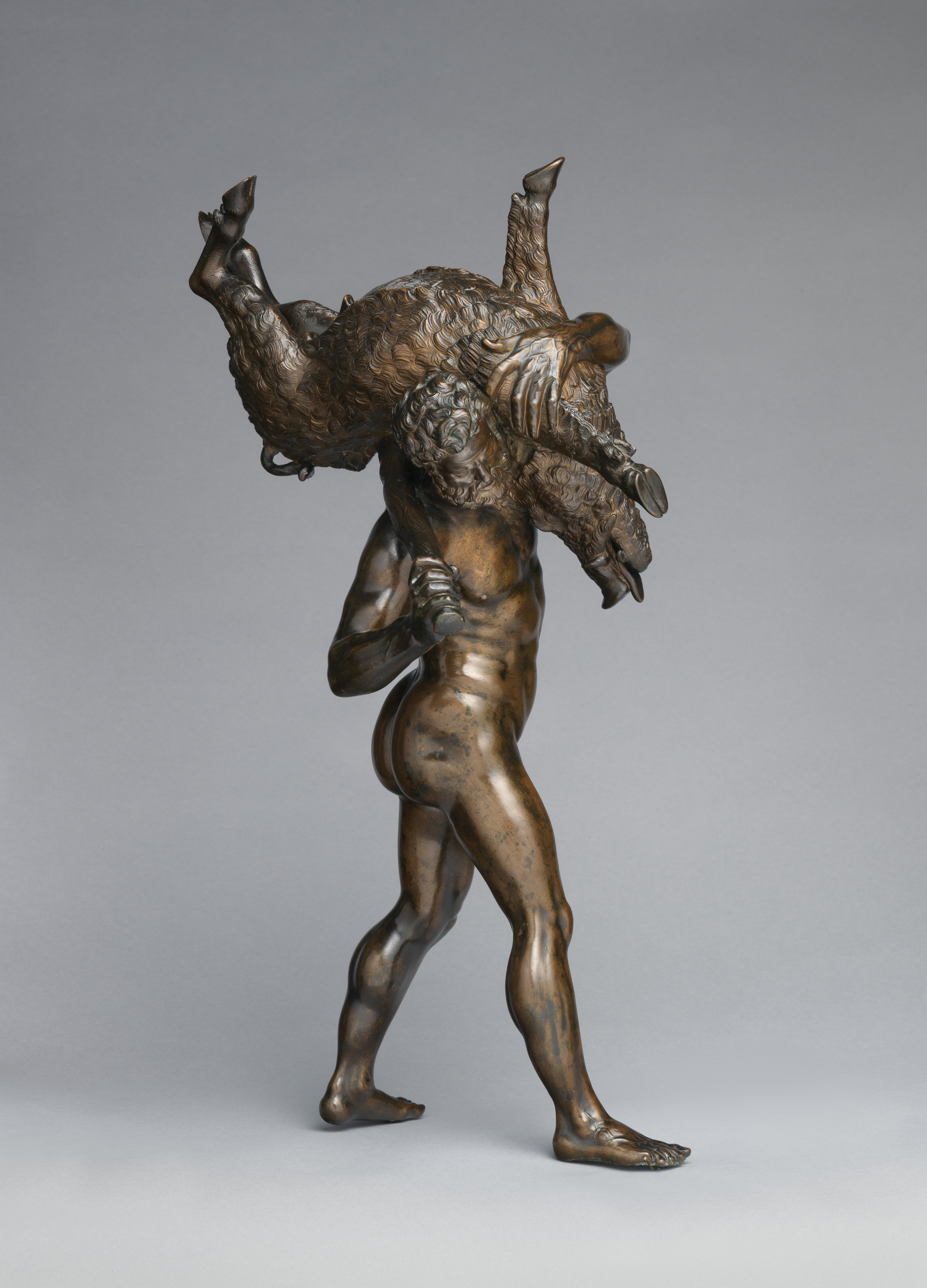Hercules and the Erymanthian boar
After a model by Giambologna Netherlandish
This bronze represents the fourth of the Labors of Hercules, in which he kills a monstrous boar that terrified the people living around Mount Erymanthus. The original composition by Giambologna was part of a series of six groups in silver depicting the Labors commissioned by Francesco I de’ Medici for the Tribuna of the Uffizi before 1576, the year of the first documentary record. Giambologna’s model for the fourth Labor was cast in silver more than a decade later, in 1589, by Michele Mazzafirri. The original silver version is lost, but several bronze casts exist. One, commissioned for Rudolf II and now in the Kunsthistorisches Museum, is unanimously considered the finest example and the earliest according to the documents, since it appears in the inventory of the imperial collections compiled between 1607 and 1611.[1]
Giambologna’s small bronzes were very popular from the end of the sixteenth and throughout the seventeenth and eighteenth centuries. Jeremy Warren compiled a list of twenty-two casts of Hercules and the Erymanthian Boar.[2] Nicholas Penny argued that many of the surviving versions are likely to be nineteenth-century sand casts because they are almost identical in their modeling.[3] Warren, however, pointed out that at least three are recorded before the first half of the nineteenth century.[4] According to Richard Stone, our statuette was cast in an excellent Florentine lightly leaded tin bronze using the indirect lost-wax method, which excludes the possibility that it is one of those nineteenth-century sand casts to which Penny referred. The alloy is quite “clean,” and the cast is extremely thin and even, with little evidence of wax-to-wax joins, supporting a later dating. Extremely light in weight, it has a warm brown patina and richly variegated tooling, such as the punch marks that articulate the club. Radiographs show that the figure was cast in one piece, with evidence of screw plugs and cast-in repairs at Hercules’s waist and shoulders and at one of the boar’s hind legs. There are large patches on the figure’s buttocks and the boar’s rump that appear to have been cut out of the bronze to access removal of the heavy ceramic core, and then reinserted with solder. The joins were carefully finished by chasing, and the patches are invisible through the translucent patina.[5]
A recent visual examination confirms that our bronze lacks the finesse of an early seventeenth-century Florentine workshop. It most certainly is not a product of Giambologna’s shop, nor can it be assigned without difficulty to followers of his tradition such as Giovanni Francesco Susini or Ferdinando Tacca. The details are mechanical—for instance, the club’s pin marks and the locks of hair—and the rendering of the anatomy quite flat. Our Hercules is comparable to the version in the Wallace Collection (S125): in both, hair and fur are repetitive and superficial (with tufts following the same design); the left hand, despite the well-delineated veins, is limp and does not dig deeply into the fur. These deficiencies are apparent when set beside the vividly chiseled surface of the bronze in Vienna. Warren places the Wallace cast in the late seventeenth or eighteenth century, a reasonable dating for the present bronze. At any rate, many questions about our Hercules and several other replicas remain stubbornly open.
-FL
Footnotes
(For key to shortened references see bibliography in Allen, Italian Renaissance and Baroque Bronzes in The Metropolitan Museum of Art. NY: The Metropolitan Museum of Art, 2022.)
1. KHM, KK 5846. For insightful discussions of Giambologna’s series of the Labors of Hercules, see Anthony Radcliffe in C. Avery and Radcliffe 1978, pp. 122–23, cats. 78, 79; Claudia Kryza-Gersch in Paolozzi Strozzi and Zikos 2006, pp. 180–81, cat. 12; Warren 2016, vol. 2, pp. 476–77, 484–87.
2. Warren 2016, vol. 2, p. 487.
3. Penny 1992, vol. 1, pp. 53–54.
4. Warren 2016, vol. 2, p. 484: the one in the Bargello is recorded in 1715; Capodimonte, 1829; Prado, 1834.
5. R. Stone/TR, June 29, 2011.
Due to rights restrictions, this image cannot be enlarged, viewed at full screen, or downloaded.
This artwork is meant to be viewed from right to left. Scroll left to view more.



